SHTFDad may collect a share of sales or other compensation from the links on this page.
For those who enjoy the outdoors but don’t want to carry around a camping knife, a pocket knife is a great tool.
However, having a great pocket knife and having one that can get the job done when needed are two different things. There are several ways to sharpen a pocket knife.
Many experienced knife sharpeners have their own unique methods that work best for them. The method we are going to cover is easy for beginners. If this is your first time, use our guide.
7 Steps to Sharpen Your Pocket Knife
For this technique, all you need is honing oil and a sharpening stone. These are very simple steps, and with practice, you will be able to put a razor-sharp edge on any knife you desire.
1. Examine The Blade
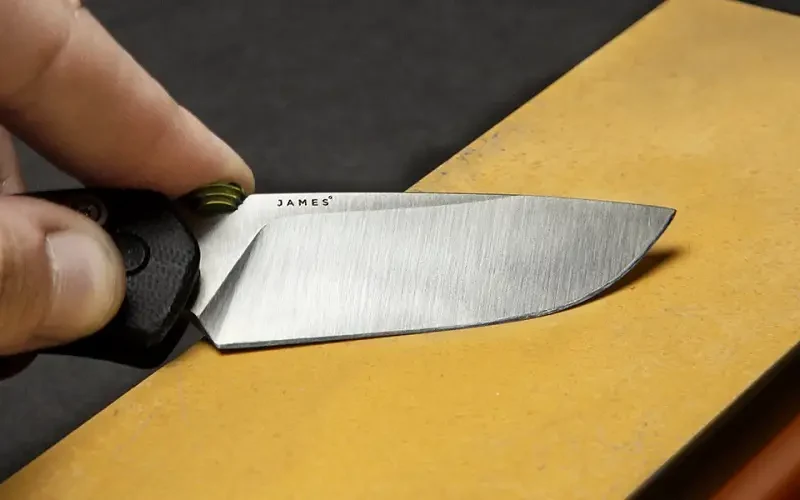
You may need to clean a used knife blade before inspecting it. Make sure there is no grease or dirt left on either edge of the blade. Then you can check it out more thoroughly.
Start by looking at the condition of the blade. If you have a dull knife, you will want to begin with the rougher grit side of the stone.
If your stone is not marked to indicate the grit level, simply drag a fingernail across its surface. You can easily identify which side has coarse grit and is more porous.
2. Prep the Stone
With the rougher side of the stone identified, you now have to prep it.
If you are using oil to hone, which we recommend because it is a little more forgiving, apply a generous amount of oil to the stone’s surface.
You don’t need to drown the stone, but you need enough.
Additionally, if you are using a brand-new sharpening stone, wait a few minutes to see if the stone soaks up the oil. If so, apply more oil until it doesn’t.
3. Choose Your Sharpening Angle
Place the knife blade on the stone so that it lays flat.
The edge angles (or the edge bevels) of knives might change depending on the type of knife, but if you raise the blade on its edge to a degree angle of something between 15 and 20, it will do the job.
These are the angles recommended by Swiss Army knife makers, and when it comes to pocket knives, there are hardly any better experts.
While you will eventually be able to tell when you have the right angle, it can be challenging for beginners to maintain a consistent angle throughout the process.
To help with your angling, we recommend using a sharpening guide. They are inexpensive and will be of excellent use if you have trouble maintaining the same angle.
4. Begin Sharpening Strokes
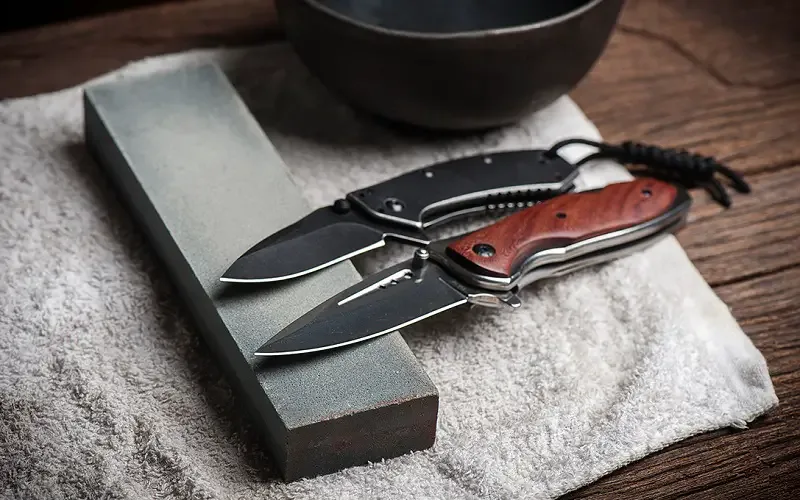
Start with your first stroke. With the blade at the correct angle, swipe down, making sure to sharpen the blade’s tip.
Ensure that the stone passes through the entire length of the blade to distribute its sharpness evenly.
Remember how many strokes you’ve made, because it’s very important to use the same number of strokes on the opposite side to achieve a sharp edge.
5. Alternate Sides
You can do a set number of strokes per side if that feels most comfortable for you.
However, it’s also ok to alternate sides, doing one stroke on one side of the blade, then flipping it over and stroked on the other side.
Whichever method you choose is up to you; just keep in mind that you have to complete the same number of strokes on both sides, or the blade’s edge will not be even, and the blade will not be as sharp as you want it.
It’s good practice to finish off with a few alternating strokes, regardless of the method you use.
6. Begin Using Fine Grit
After completing the process on the rougher side of the sharpening stone, flip it over and repeat the steps with the finer grit.
Remember to apply a generous amount of lubricant and test for absorption.
7. Strop Your Blade
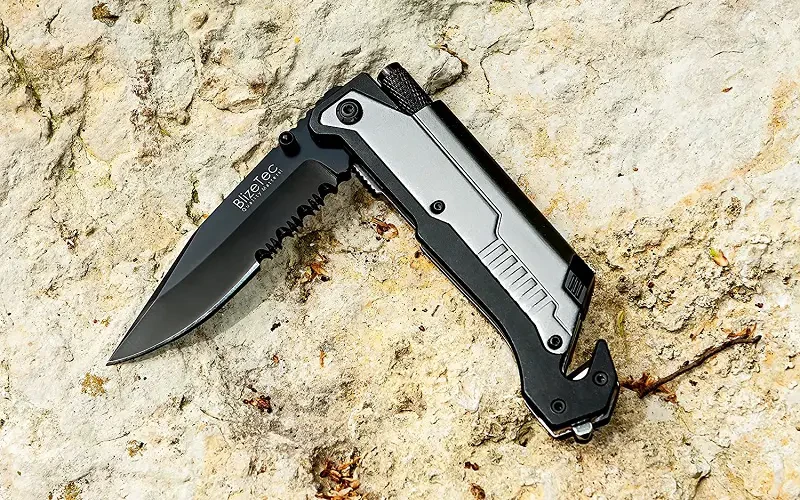
Although you don’t need to do this after all the sharpening, stropping a sharp blade can help preserve its condition longer than usual because it gives its edges better protection and a better look.
For this, you need a leather strap, or even just a piece of leather, and a polishing compound or paste.
First, apply the polishing material to the leather, and then you can start polishing the blade by moving it on the leather up and down.
While doing so, the blade’s cutting edge should be away from the leather. Otherwise, you might cut the leather, or your knife might become dull again.
Necessary Tools
As we stated above, all you need to sharpen your pocket knife is a sharpening stone and a lubricant.
However, if you have already started looking at all of the different types of sharpening stones available, you are undoubtedly overwhelmed by the choices.
Look for these in a sharpening stone and lubricant.
1. Sharpening Stone
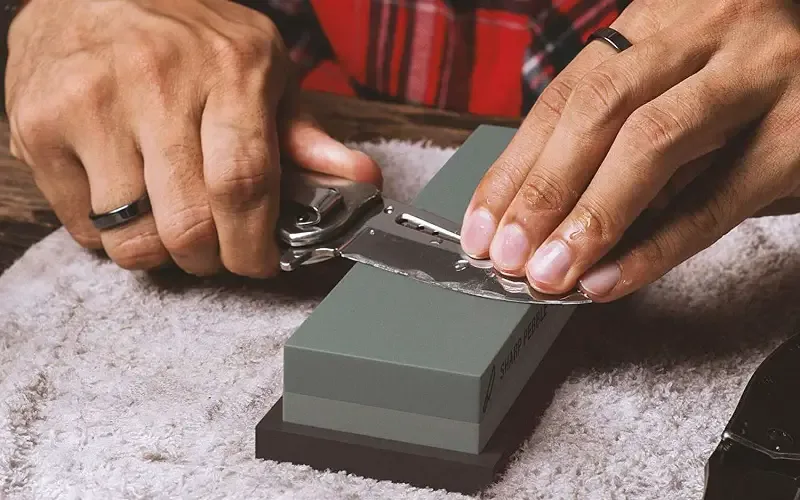
Sharpening stones, also known as whetstones, are available in many different styles. Some of these stones feature two sides, each with varying grit levels. Typically, there will be a rougher side and a smoother side.
There are also high-end stones encrusted with diamond dust on their surface. Other high-end stones used for sharpening are known as Japanese water stones, which are meant to be used with water instead of honing oil.
Once you become more proficient at sharpening knives, the type of stone you choose typically depends on the knife’s function and your preferences.
Only trying different stones can determine which one works best for you. For novices, it’s crucial to consider several factors.
If you are trying to sharpen a high-end pocket knife or a hatchet, you probably don’t want to buy the cheapest stone available in the stores. The low-quality materials used to make the stone could damage your knife blade during sharpening.
Some are expensive, but that doesn’t mean you should buy them. Buying a high-end model might not be the answer. If you’re just starting out, sharpening your knife on a decent basic sharpening stone will be perfect.
Here are some of the relatively popular types of sharpening stones and their respective applications:Oil stones:
- Oil stones: These are the types of stones you would find in your grandpa’s house. They are available in most hardware stores and are excellent for adding a stylish edge to your knife. Most hardware stores carry them, which are excellent for enhancing the edge of your knife. However, if you are working with an older knife that has a very dull blade, this type of stone can take a long time to get the desired edge due to its typically finer grit.
- Diamond Stones: Diamond stones are excellent for getting a razor-sharp edge on your blade. You can purchase diamond stones like Smith’s DCS4 for less than $20, and they have a lifetime warranty. Diamond dust embedded on the blade will be useful for hundreds of sharpenings and will last you forever.
- Ceramic stones should only be used after extensive experience. If you are a beginner, you should be careful when picking a ceramic stone because the quality of the ceramic plays a huge role in how well it does its job. If they are too hard, they glaze over and become ineffective. If they are excessively soft, they will quickly deteriorate and necessitate replacement. They also require a lot of care. With proper technique and experience, though, you can get an edge like no other with a ceramic stone.
- Synthetic: Synthetic stones are becoming one of the more popular options. Some require light lubrication, while others require a soaking period before you can use them. These are ideal for western-style knives. Synthetic stones like Smith’s TRI-6 Arkansas combine excellent material engineering and design to produce an easy-to-use tool that sharpens your pocket knife’s edge.
- While natural stones are probably the best you could ever get your hands on, they are also the most expensive. Once mined in Japan, natural stones give your knife a long-lasting edge due to the random grits found in the stone. Regrettably, most Japanese mines have now ceased operations. This results in a limited supply, which in turn drives up the price tag.
Find a sharpening stone that has at least two different grit levels: a rougher grit and a smoother grit. If you are working with a really dull blade, you will need the rougher grit to shape it and the finer grit to ensure a smooth edge on it.
The size of your knife will play a significant role in determining the size of the stone you will need. While 6-inch, 4-inch, and 3-inch stones are common and more than adequate for smaller knives, larger knives will require a larger stone.
If you have a larger knife, consider using an 8-inch stone. Keep your budget and need for a sharpener in mind. If your knife is to be a daily-use tool, you will want to have a quality stone at hand to hone it.
However, excellent stones can have a high price tag. Don’t overspend on something you will only need occasionally.
2. Honing Oil
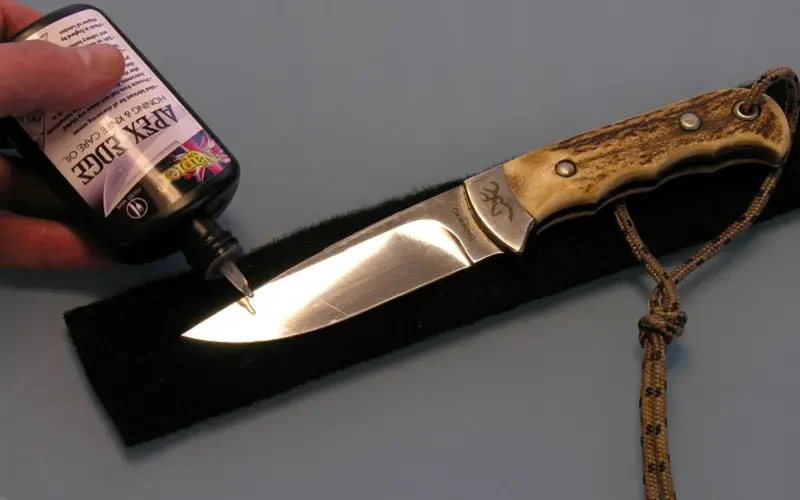
When you sharpen your pocket knife, honing oil acts as a lubricant in order to prevent the stone from damaging the blade.
When you run your blade across the stone, metal shavings from the sharpening process can accumulate on it, making it less effective.
Some people use water as a lubricant; others use mineral oil. However, you can buy honing oil designed specifically for knife sharpening. Additionally, sharpening friction can damage your knife blade.
The oil is there to prevent that, too. Now that you know everything necessary to sharpen a pocket knife, you can go enjoy your razor-sharp tool outdoors.
Whether you find yourself whittling away using it as a whittling knife or setting traps and snares using your bushcraft skills, you can always count on having a sharp pocket knife.
Wrap-Up
If you’ve used it frequently, you’ll probably know when it’s getting dull.
For extra assurance, test its sharpness with paper. Hold a piece of paper and try to cut through it. If your blade tears the paper instead of cutting it, you have a job.
Congratulations! You now know how to sharpen a pocket knife. Even better, you have a sharp knife! And thanks to the stropping, it looks pretty polished and cool, too!
Overall, the process of knife sharpening isn’t too hard. The key is to maintain a constant angle throughout the process. As long as you keep this in mind, everything else will be a cakewalk.
